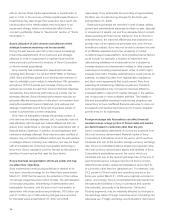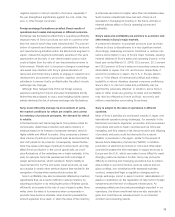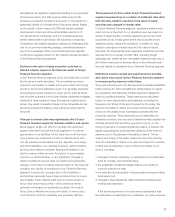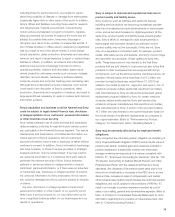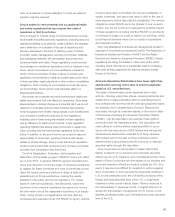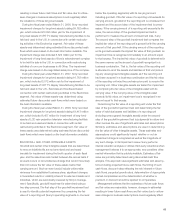Sony 2008 Annual Report Download - page 80
Download and view the complete annual report
Please find page 80 of the 2008 Sony annual report below. You can navigate through the pages in the report by either clicking on the pages listed below, or by using the keyword search tool below to find specific information within the annual report.78
may be inadequate. In addition, any changes in regulatory
guidelines or standards with respect to the required level of
policy reserves may require that we establish policy reserves
based on more stringent assumptions, estimates or actuarial
calculations. Such events could result in a need to increase
provisions for policy reserves, which may have a significant
adverse effect on the financial condition and results of
operations of the Financial Services segment.
Sony’s music business, including its investment in SONY
BMG, and the Pictures segment are subject to digital piracy,
which may become increasingly prevalent with the develop-
ment of new technologies.
The development of digital technology has created new risks
with respect to Sony’s ability to protect its copyrights in its
music business, including its investment in SONY BMG, as well
as in the Pictures segment. Advances in technology that enable
the transfer and downloading of digital audio and video files
from the Internet without authorization from the owners of rights
to such content threaten the conventional copyright-based
business model by making it easier to create and redistribute
unauthorized audio and video files. These technological
advances include new digital devices such as hard disk drive
video and audio recorders, CD, DVD, and Blu-ray Disc™
recorders and peer-to-peer digital distribution services. Such
unauthorized distribution has adversely affected sales and
operating income within the music business, and returns from
Sony’s investment in SONY BMG, and threatens to adversely
affect sales and operating income in the Pictures segment. As a
result, Sony has incurred and will continue to incur expenses to
develop new services for the authorized digital distribution of
music, movies and television programs and to combat unau-
thorized digital distribution of its copyrighted content. These
initiatives will increase Sony’s near-term expenses and may not
achieve their intended result.
Sony’s music business and Sony’s investment in SONY
BMG are dependent on establishing new artists, and
together with Sony’s Pictures segment are subject to
increases in talent-related costs.
The success of Sony’s music business and Sony’s investment
in SONY BMG is highly dependent on establishing artists that
appeal to customers, and the competition with other enter-
tainment companies for such talent is intense. If the music
business and SONY BMG are unable to find and establish
new talented artists, sales, operating income and the returns
from Sony’s investment in SONY BMG may be adversely
affected. In addition, with respect to the music business and
the Pictures segment, as well as SONY BMG, Sony has
experienced and may continue to experience significant
increases in talent-related spending.
SONY BMG may be subject to renewed judicial review by
the European Court.
In August 2004, Sony combined its recorded music business
outside of Japan with the recorded music business of
Bertelsmann AG, forming SONY BMG, after receiving antitrust
approval from, among others, the European Commission. On
December 3, 2004, Impala, an international association of
2,500 independent recorded music companies, appealed the
European Commission’s clearance decision to the EU Court
of First Instance (“CFI”). On July 13, 2006, the CFI annulled
the Commission’s decision to allow the merger to go forward,
requiring the Commission to re-examine the transaction. In
October 2006, Sony Corporation of America and Bertelsmann
AG filed an appeal of the CFI’s judgment to the Court of Justice
of the European Communities (“ECJ”). The ECJ is scheduled to
render judgment on that appeal on July 10, 2008. On October
3, 2007, following its re-examination of the merger, the
Commission rendered a second clearance decision reaffirm-
ing the conclusion reached in 2004 that the transaction raised
no competition concerns. That decision may be appealed to
the CFI until June 26, 2008 and on June 16, 2008 Impala
announced it had filed an appeal. If the ECJ were to affirm the
CFI’s judgment annulling the Commission’s original clearance
decision and the CFI (and upon a further appeal, the ECJ) were
to annul that second clearance decision, then, should the
Commission following a further investigation reverse the
position it had taken in 2004 and 2007, the previously com-
bined company could be forced to unwind the merger in whole
or in part. In such circumstance, Sony might incur significant
costs and might not be able to achieve its objectives with
respect to its recorded music business.
Sony may not be successful in implementing its hardware,
software and content integration strategy.
Sony believes that utilizing broadband networks to facilitate the
integration of hardware, software and content is essential for
differentiating itself in the marketplace. Sony also believes that
this strategy will eventually lead to consistent revenue streams.
However, this strategy depends on the development (both inside
and outside of Sony) of certain network technologies, coordina-
tion among Sony’s various business units, and the standardiza-
tion of technological and interface specifications across
business units and within industries. If Sony is not successful in
implementing this strategy, it could adversely affect Sony’s
competitiveness and profitability.
Sony’s physical facilities and information systems are
subject to damage as a result of disasters, outages,
malfeasance or similar events.
Sony’s headquarters, some of Sony’s major data centers and
many of Sony’s most advanced device manufacturing facilities,








